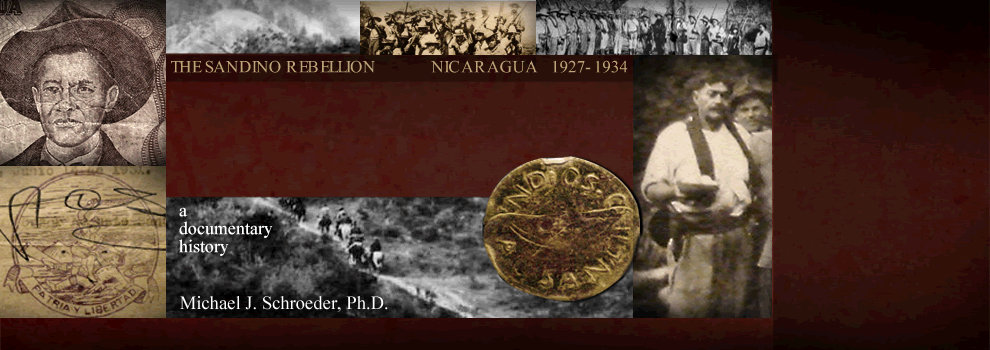|
 THIS IS THE FIRST PAGE
of documents for the FIRST HALF of 1932
on Nicaragua's Caribbean Coast
region, housing documents dated in the 35 days from January 1
to February 4.
THIS IS THE FIRST PAGE
of documents for the FIRST HALF of 1932
on Nicaragua's Caribbean Coast
region, housing documents dated in the 35 days from January 1
to February 4.
Licking their wounds &
regrouping after a series of
lucrative raids, inconclusive
skirmishes, and at least one costly
defeat, the rebels mark the new
year’s opening weeks by suspending
their campaigns in the Coast and
retreating back into their camps in
the deep interior of the Tuma, Bocay
& Upper Coco valleys. Details
about the events of late 1931
continue trickling out of the
Guardia’s intelligence-dissemination
apparatus, as we see in this page’s
first document, a report on the
EDSN’s deadly mid-December raid on
Siuna & Wuani mining districts (Jan
1). Col. Leech’s summary of
events for December 1931 briskly
synopsizes the year’s major military
events in the Eastern Area, which
include 14 military contacts & an
estimated 60 rebels killed & 18
wounded, compared to 3 Guardia
killed & 7 wounded (Jan 8).
Seeking to prevent yet another
repeat of the rebels’ periodic
plundering raids on Siuna & Wuani,
in mid-January the Guardia establish
a small permanent post at Wuani (Jan
12 & 15). Around the same time
a small group of rebels raids
Brown’s Camp (in the logging zone
along the railway west Puerto
Cabezas, report of 21 Jan), followed
at month’s end by a raid on Tunky
and, soon after, yet another on
Neptune Mine (McAffee reports of 2
Feb), followed by a small indecisive
action against the Kisalaya garrison
(4 Feb).
But by early February the tables seem to be turning,
with the rebels’ plundering offensives
turning defensive & the Guardia
embarking on a series of aggressive
offensives in the deep interior.
Emblematic of the war’s shifting
dynamics on the Coast’s northwestern
frontier is Lt. Gray’s relentless
pursuit of the rebels who raided
Neptune Mine on 1 Feb. Completely
surprising a "large group" of
about 75 plunder-laden Sandinistas
encamped on the mouth of the Río
Biltigne as it flows into the
Waspuk, on Feb 2 & 3 Gray’s 12-man
patrol decisively routs the rebels,
killing six, in "the most severe
blow the bandits have been struck on
this coast” & resulting in “the
largest recovery of stolen loot in
the history of the Guardia" —
including a “mass of papers,” a good
number penned by Sandino, that
include many of the EDSN documents
presented here (Feb 4).
Other notable documents below include Moravian
Church Brother C. Conrad Shrimer’s
revealing discussion of the shady
financial activities of Brother
Schramm & his wife on the Rio Coco &
at Musawas (Jan 18); Bishop Guido
Grossman’s pointed critiques of the
politically retrograde actions of
the Catholic Church on the Coast
from the mid-19th century to the
present (Jan 6); and the Managua
daily Diario Moderno's
summary of Senator Juan Cajina
Mora's speech before the National
Assembly, decrying the "bandit"
camps & gangs from Puerto Cabezas
inland to the mining districts &
beyond, and calling for "good
measures" to protect lives &
properties & restore "confidence,"
"order," "constitutionalism" &
"work" to the nation as a whole (Jan
13).
|
|
PERIOD MAPS
|
|
1894 mosquito
shore

27 MB,
library of congress
|
1920s
Standard Fruit

6.5 mb,
US National archives
|
1928 Rio wanks
Patrol

3 mb, us
national archives
|
1931 Moravian

2.4 mb,
comenius press
|
|
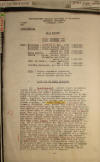
|
1 January
1932.
Extracts from
GN-2 Report Covering December
1931.
[NOTE:
These excerpts constitute the
sum total of text devoted to the
Atlantic Coast region in this 40-page
intelligence report covering the entire
country, except the p. 27 extract from
Col. Leech's Record of Events for the
Eastern Area for Nov. 1931. The image to
the left is the report's cover page
only.]
" [p. 1]
LOCATION OF THE
ENEMY ELEMENTS. ¶ (A)
SANDINO: . . . One Juano Gonzalez, a
prisoner and formerly Colindres’ cook,
states that . . . some black (negro)
bandits are among Sandino’s supporters.
. . . ¶
[p. 3]
(C) PEDRON
ALTAMIRANO: . . . Reported to have
sacked SUIBANC WAUNI (Dept of
Prinzapolka) with group of 400 on
December 20. Salgado, Gonzalez and
Rivera reported with him. This
group reported at Tungla (Dept of
Prinzapolka) on December 24. . . .
¶ (E) CARLOS SALGADO: Reported
with Pedron Altamirano on December 20 at
SUIBANC WAUNI . . .
[p.
6] ¶
(T) MARCIAL RIVERA: . . . Reported with
Pedron Altamirano at SUIBANC WAUNI . . .
on Dec. 20. [NOTE: Of the 24 rebel jefes
surveyed in this section, these are the
only references to the Eastern Area] . .
. ¶
UNITS IN CONTACT. ¶ .
. .
[p. 7]
DECEMBER 6: Kisalaya (Eastern Area)
patrol had contact one mile south of
Kisalaya. [NOTE: Of the 17
contacts in December, only one was in
the Eastern Area] ¶ . . .
[p.
8]
STRENGTH AND
MOVEMENTS: ¶ . . .
[p.
9] Large group
reported at fork of Pis Pis and Waspook
Rivers (Dept of Cabo Gracias a Dios) on
December 24. ¶ . . . The
following extract from Record of Events
for November of the Eastern Area is
quoted: ¶ 5.
INTELLIGENCE:
¶ (a) Decided conditions of
unrest. ¶ (b) From constant
and presumably reliable information
there is now a group of bandits from 200
to 300 on the Wanks River scattered from
Waspook to Tilba Falls, the larger part
of the group is based at Sousa
Plantation. The outfit is
apparently well armed, equipped and
organized. The Leader of this
group is believed to be either Rivera,
Simeon Escobar or Gonzales.
Approximately two weeks ago a large
detachment of from 50 to 100 from this
group moved up the Waspook River,
destination and intentions unknown.
The Jefe is believed to be Chavarria.
I believe this group has one of three
objects in view. ¶ 1.
To come down the Pis Pis trail through
Kukalaya to the Commissaries in the
Vance District; or ¶ 2. To
go due south into the Mining districts;
or ¶ 3. To turn west and
join a large bandit group under
Altamirano which is located somewhere
between Casa Viejas and Bocay. ¶
There is still a group of from 50 to 75
remaining in the vicinity of Cruta and
Caratasca Lagoon north of the Cape. They
might have intentions of raiding the
Cape but their main object is to handle
the smuggled supplies and ammunition
that are being constantly landed in that
area by schooners. [NOTE:
This report, said to be
extracted from the Intelligence section
of the Eastern Area Record of Events for
November 1931, does not correspond to
the Intelligence section of the Eastern
Area Record of Events for November 1931
that is published elsewhere on this
page. I cannot explain the
discrepancy, and can only speculate that
either a supplementary report was issued
superseding the foregoing report, or the
GN-2 compilers got the date wrong.] ¶
[p.
10]
MOVEMENTS:
¶ [NOTE:
Of the 28 items in this section, none
concern the Eastern Area.] . . .
[p.
13]
ENEMY SUPPLY AND EQUIPMENT.
¶ . . . Information received late
in the month reports a shipment of arms
and ammunition received by the bandits
via the Patuca River, after having been
landed in the vicinity of Laguna de
Caracasca, Honduras, on the Atlantic
side. ¶ . . .
[p.
25]
MISCELLANEOUS.
¶ . . . The situation in Kisalaya
(Dept of Cabo Gracias E.A.) is much
better than originally reported
according to latest report from Area
Commander, Eastern Area (Dec 7). ¶
. . .
[p. 26] Constant
reports are coming to Cabo Gracias a
Dios (EA) by Indians that there is a
band of fifty to seventy five bandits
situated in the area of Caratasca
Lagoon, mouth of the Patuca River and
Honduranian Cruta. It is claimed these
bandits are there to look after arms and
ammunition being smuggled into the
Lagoon and thence up the Patuca River to
Sandino’s Headquarters. The
Indians on the Upper Coco River state
freely that Sandino is constantly
transporting arms and ammunition up the
Patuca River. ¶ . . . "
|
|

|
1 January
1932.
Intelligence Report on Bandit
Activities, Capt.
O. A. Inman, Puerto Cabezas.
"... Subject:
Intelligence Report on Bandit
Activities. ¶ Enclosures: 1.
Receipt to Sebastian Ismael by Abram
Rivera for Property Taken at Siuna.
¶ 1. Transmitted herewith is a
receipt to Sebastian Ismael by Abram
Rivera for property taken from him at
Siuna on 14 December 1931. The
Anderon has arrived here from
Prinzapolka on 30 December 1931 bringing
Sebastian Ismael and Mr. Stantin from
Siuna. ¶ 2. Questioning
elicited the following information:
¶ Early in the morning of 14
December 1931 Irias at head of about 100
men attacked the Siuna Mine and caught
everyone by complete surprise.
He remained around Siuna for a number of
days burning the houses and holding
various people in custody. Looting
and robbery were his main suits. ¶
On Wednesday the 16th Pedron Altamirano
joined him in Siuna with about 200 more.
As soon as Pedron appeared he began his
butchering of the people held, killing
Charlie Hasslan [Haslam] and about five
natives. All the shopkeepers were
stripped of their stock and given
receipts for value received. A
receipt held by Sebastian Ismael for
five hundred dollars is held here.
The Comandante of Siuna escaped and came
up on the "Anderson" with a German by
the name of Stantin. ¶ On
Friday the 18th the whole outfit left
Siuna on the trail leading to the
Electric Light Plant of Neptune Mine but
their progress has been slow due to the
sickness of the men in ranks and
soreness of feet. Pedron spoke of
returning a widow of one of the dead to
Matagalpa but that may simply have been
a ruse to get her to accompany the
bandits on the trail more easily.
There was also talk of burning Neptune
Mine and Puerto Cabezas in the near
future. ¶ All the bandits
are equipped with a rifle and a machette
and two hand bombs. The rifles are
of all classes and calibers. 75%
of the band were Indians from Segovia
and the Upper Coco, not to be used as
machete men but as actual fighting men.
Pedron has 3 riot gns, 2 TSMG's, and 2
BAR's. Irias has 1 TSMG. Each man
has about 40 rounds of ammunition.
¶ Jefes recognized by Stantin who
employed most of them at the San Albino
Mines were Pedron, Irias, Gonzalez,
Palma, and Abram Riviera. Another
Jefe who went to Wuani was Julio Castro.
¶ There are in Siuna these people
who are known to be giving aid to the
bandits and are supplying them with all
necessary information: Pedro
Moncada, a cook by the name of
Celestino, and a wanton by the name of
Bertha. ¶ /s/ A. O. Inman"
|
|

|
4 January
1932.
Intelligence Report,
Capt. O. A.
Inman, Puerto Cabezas, to Col. L.
L. Leech, Bluefields, p. 1.
"... Subject:
Intelligence Report. ¶
Enclosures: (1) Statement of Ramon
Rodriguez (Guardia agent) taken down by
Lieut. Stephenson at Kisalaya. ¶
1. The Department Commander questioned
the above mentioned man (mosquito
indian) but could gain very little more
information. He was sent up the
river over one month ago and made his
escape from the Bandits about the 24th.
of December. Air reconnaissance,
made by the undersigned on the 31st. of
December, leads me to believe that a
great part of Rodriguezs' statement is
true. There were no signs of life,
boats or inhabited houses until we
reached the second village below
Waspook--marked "Buk Buk" on the Pefley
Map, from there to Sang Sang every
village had an excessive number of
boats--a great many of them filled with
fruits, scraps of clothing and cooking
utensils. Each village showed
signs of recent activity and a greater
number of cooking utensils on the decks
of the houses than should normally be
necessary but not a man, woman or child
was seen. ¶ 2.
Kisalaya also reports that on the night
of 1 January 1932 a bomb was exploded in
the vincinity of Laimus and an answering
report to the south of Kisalaya.
Patrols from there have been covering
the trails to the north and south daily.
Fresh tracks leading both east and west
have been found on the trail near Laimus
on 3 January. From the appearance
of the tin can covering it could not
have been left for more than a week.
Patrols from the Line and air
reconnaissance have failed to find any
trace of bandits between Puerto Cabezas
and Coco River. ¶ /s/ O. A.
Inman"
|
|

|
4 January
1932.
Intelligence Report,
Capt. O. A.
Inman, Puerto Cabezas, to Col. L.
L. Leech, Bluefields, p. 2.
"Statement of
Ramon Rodriguez, a resident of Wasla,
sent by the Guardia Nacional on a
mission of espionage and in a search for
Company animals taken by bandits from
Louisiana Farm," 3 Jan. 1932.
|
|
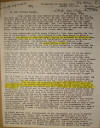
|
1.
6 January 1932.
Letter from Guido
Grossman, Moravian Church,
Germany, to Brother Shrimer, Nicaragua,
p. 1.
"My dear
Brother Shimer:- ¶ Many thanks for your
favour of Dec. 5th. , which came to hand
a few days ago. It was written on the
5th. Of Dec. but started on its journey
from the post office, according to the
date on the stamp only on the 11th. Of
December. It met me in a poor condition
[sic] for I am suffering for six weeks
already from a very painful “neuritis”,
but I am improving day by day, and I
hope that I may be able to go out for a
short walk soon. The weather is very
unfavorable, all the time rain and wind,
instead of snow and ice. Only about a
week the children were able to use their
sleighs. ¶ Now to your communication.
With great interest I have been reading
the letter of Sr. Gutierrez C., also the
clipping of some newspaper in which a
speech of the bishop of Rome delivered
before an audience in Bilwi, in which he
lamented over the poor people of the
Atlantic Coast, not being able to speak
Spanish, because the Moravians had not
taught them so to do. No doubt the
audience was of the conservative order.
The Bishop as usual, blames the Moravian
missionaries that we have neglected to
nationalize the coast, and of course, if
we had done it, then he would have found
something else to pick at us [sic]. ¶
What has the Catholic church done in
that respect? They are on the coast
since 1889! They have taken away the
building of municipal schools in
Bluefields, but have never been able to
do proper school work, they have mixed
in all kind of bad and unclean politics,
that even some of their priests had to
run away! Where is there progress of
nationalizing the coast? No, Rome hates
us and they will use all opportunities
to speak against us, because we teach no
Spanish, but that is only firework! The
real truth is: we preach the GOSPEL,
therefore they hate us! What has the
Church of Rome done to the Indians in
Central and South America? Someone has
called these people “the poorest
creatures on God’s earth,” The church of
Rome has this on its asset. The C.
Church has nowhere nationalized, but
only Romanized the people! ¶ But of
course it is of no use to talk about
this, Rome will never admit this and
they will always find a certain class of
people in each country, who will follow
them and admire them as the only true
uplifting power. So also in Nicaragua.
Rome through the capuchins invaded the
coast (in) 1916 with the only purpose,
as the Bishop announced it in Managua in
his sermon: “we go to the coast to
counteract the immoral and evil
influence of the Moravian Missionaries.”
The attack was to come, I have written
time and again about this danger, that
we have to be on the look out and see
that they do not find us unprepared.
They have kept back with their forward
movement on the Atlantic Coast, for
reasons unknown, and if they start now
with it, they have selected indeed a
time where we are weak. It shows plainly
how they watch us! But now dear Brother
Shimer I do not understand how in face
of this attack you can advocate for
leaving: Haulover, Karawala and Sandy
Bay without a missionary. What will our
people think of us, if we leave them at
such a time alone, without any support,
we just expose them to the propaganda of
Rome, and you can rest assured that
those capuchins will use the sweetest
tone in their propaganda to make it
palatable for the Indians, that they are
right and we are wrong ! ¶ As remedy
against this announcement of the
propaganda you think to employ this Sr.
Gutierrez. I really fail to see how this
can help us? I am very sorry, dear
Brother Shimer, but I do not understand
the meaning of your sentence: “unless we
do something in the Spanish tongue, I am
afraid we will loose [sic] many of our
people”. I personally just the opposite!
[sic] We should speak louder in English
and louder in Miskito to our people of
the power of the cross, and we should
lift higher up in English and Miskito
the high and . . . "
|
|

|
2.
6 January 1932.
Letter from Guido
Grossman, Moravian Church,
Germany, to Brother Shrimer, Nicaragua,
p. 2.
". . . noble
ideal of the Evangelical Christian
Church. Sr. Gutierrez cannot stop the
advance of the Church of Rome, if they
choose to launch it at this time, we are
too weak to take the offensive, no I
think we have rather to strengthen our
own congregation and defend that what we
have. What will Sr. Gutierrez do when
they occupy Haulover and Sandy Bay and
Karawala? We neither can do much when
they take possession of Yulu or Pearl
Lagoon, but there we would be on the
spot, and we can at least there do our
duty and advise our people on the hand
of the Word of god, what to do. ¶ Let us
just be quite clear and I think it does
us good when we call to remembrance what
has passed on the Atlantic Coast of
Nicaragua. We regret that we have not
been able to do more in Spanish, yet
after all it was not our business, I am
sure of that. Also I am certain of that:
if the Government of Nicaragua would not
have closed our school in 1900, when we
were preparing to put our schools on the
governmental plan, we would have been
able to show better progress in that
line. Dear Bro. Shimer the need of
Spanish has been seen by us in former
years, but various reasons have
prevented the carrying out. First of all
let us look at the Government, it was
determined to eliminate our schools
altogether. And what have they done?
With much ado they opened the “Colegio”
the light is coming to the Atlantic
Coast now”, but what have they done,,
after a few years of working with great
expenses, they had to close the
“colegio. They had a few Miskito boys in
the “colegio” they turned out to be
rascals. Only one of them, after he
became converted, if I rightly remember
through the aid of our Bro. Danneberger,
became a decent man and a useful member
of our church. After the declaration of
the “libertad de Ensenanza” (in ) 1910
we were unable to establish our schools
again,, as the General Synod (of) 1909
had decided that our province should
retrench its activity on account of the
financial trouble. Then came the war.
But in spite of that, with the aid of
Bishop Hamilton we were permitted to
call Bro. Cruikshank into the field. He
was willing to bring the President and
the Minister of Public Instruction, all
kind of promises we were made, but not
one was kept, and as we ourselves could
not think of putting the plan through
without any aid of the government we had
to drop out plan. And what had the
Government done? It showed us very
little interest (in) the need of the
people on the coast. When in 1923 the
American Consul asked me how many
schools the government entertains on the
Atlantic Coast, and I told him: one he
jumped from chair and said you must be
mistaken, for there are 32 on the
payroll. That was the conservative
Government, the same people who
applaused [sic] the catholic Bishop when
he stated that the Moravians are to be
blamed that the coast people do not
speak Spanish (by the way there are many
people of the coast who speak a better
Spanish than some of the officials) and
that we have neglected our duty to
nationalize the coast. ¶ It is not our
duty to nationalize this coast, it was
the duty of the government, but it has
failed to do so, in the contrary,
especially the conservatives have done
everything to destroy through their
unjust and unfair dealing with the
coast, what we have done in reconciling
the coast with the interior. And the
doings on the
Wankgs-Musawas-Tuburus—whereby the
hatred towards the “Spaniards” has been
inflamed anew, are not perhaps the
conservatives at the bottom? No instead
of applausing [sic] a man who blames us
for something what they themselves
should have done, they should sit in
sack cloth and ashes. ¶ Again I admit
that we could have done more in teaching
Spanish, but on the other hand whilst we
were handicapped in our school work, and
were not able to meet the requirement of
the Government. In our real mission we
have been endeavored to discharge our
duty. In spite of retrenchment and being
undermanned and financial trouble the
Lord had opened doors to enter in to
preach the Gospel, and He has given us
natives who were willing to enter in
faith and the Lord has given us
everywhere a great harvest. Just study
the statistics of the last 15 years and
they show you, that the Lord has blessed
our efforts to evangelize the Atlantic
Coast. . . ."
|
|

|
3.
6 January 1932.
Letter from Guido
Grossman, Moravian Church,
Germany, to Brother Shrimer, Nicaragua,
p. 3.
". . . That was
our duty to us by God. Our Brethren and
Sisters at home do not give their money
for nationalizing this coast of
Nicaragua. But that we should bring them
the Gospel. ¶ Furthermore in regard to
Sr. Gutierrez I do not know what to
think of him. He is evidently very
fickle in his aims and plans. Last year
he almost became a “Salvation-army-man”.
He had gone so far already that
Brigadier Joy has taken the ticket for
their passage to Jamaica. In the last
moment he withdrew. Now again he is in
correspondence with the “Misiones
Medicas” Mexico to study medicine, as
you will see from the letter which I
enclose. At the same time he offers his
service to us! What does he mean? Does
he wish to burden us with his work, and
then leave us and go to study medicine?
Or does he expect, when he is employed
in our service, that we will take some
responsibilities over against his wife
and child, whilst he is away to study
medicine which would mean 6 years I do
not know, yet it puzzles me, that he has
these two irons in the fire at the same
time! ¶ In case he does study medicine,
what are we then to do with the Spanish
Congregations, which he has handed over
to us? According to my feeling it would
be out of place to engage a special
Spanish worker for these Spanish
congregations at a time where we have to
leave our own people, who have the first
claim on us unprotected against the
attack of the Romans. Again I beg to
emphasize that I personally do not see
how the commencement of Spanish work at
the present time can help us, and how
this can prevent us from loosing [sic]
many of our people. ¶ In regard to
Palmer’s I read what you write to Bro.
Danneberger. I agree with you that he
should be sent away from Bluefields. I
would give him a call to Karawala. I do
not think that Sandy Bay would be the
place for him. The Sandy Bay people are
too independent for Palmer, he would
have trouble with them. But Karawala
would do for him at least for the
present. Anyhow I think when the attack
of the Romans should come, he might
stand the battle and help his people to
counteract the enticement of Rome. But
if he goes to Karawala and his family
remains in Bluefields there will be, I
am afraid a continually going to and
from between these two Ports. ¶ I am
glad to say that Sr. Wolff is improving.
When are the Hamiltons coming to
Bluefields? May the Lord bring them
safely into their work. ¶ Now my dear
Brother Shimer, may the Lord guide you
in all your work, so that His will be
done, then let us not be afraid. He will
be with us. With my best wishes, ¶ Very
sincerely yours, ¶ [signed] Guido
Grossman"
|
|

|
8 January 1932.
Extract from Record of Events, Dept. of
Northern Bluefields for December 1931,
Capt. O. A.
Inman, Puerto Cabezas.
|
|

|
1.
8 January
1932.
Record of Events, Eastern Area, December
1931, Col.
L. L. Leech,
Bluefields, to
Jefe Director GN Managua, p. 1.
"... E.
Intelligence. ¶ 1. The
general state of the territory occupied
is satisfactory. The coastal
cities continue their industries in
freedom and without molestation from
bandit sources. During the period
a large bandit column passed SOUTHWEST
to NORTH through the NEPTUNE-LA LUZ-PIS
PIS mining regions, killing four natives
and burning a few buildings in the
isolated and ungarrisoned towns of WUANI
and SIUNA. A small group of
bandits appeared near KISALAYA, and were
routed by Lieutenant STEPHENSON'S
patrol, with a loss of four (4) bandits
killed. At the end of the period,
report of bandit activity within
striking distance of Guardia Stations,
was negative. ¶ 2. Military
Situation: With inclusion of the
November 29th contact of NEPTUNE
guardia-civicos with the CHAVARRIA group
at SULUN, and Lieutenant STEPHENSON'S
action near KISALAYA, bandits in the
Eastern Area suffered two positive
defeats in the period. It has been
assumed for several months that a bandit
concentration camp exists at BOCAY.
Direct bandit information from a
mortally wounded outlaw at KISALAYA
indicates intermittant bandit occupation
of settlements on the COCO RIVER, as far
down EAST, as WASPOOK. Direct
information from a dying bandit at SULUN
indicates, in fairly reliable degree
that a bandit concentration camp now
functions at AWAS-BILA (PEFLEY MAP).
It is apparent that NEPTUNE MINE was to
have been attacked by the CHAVARRIA
group during December. The SULUN
action was a disastrous and effective
blow for CHAVARRIA force, and probably
prevented an attack on NEPTUNE MINE.
A refugee from WUANI and SIUNA bandit
raids, heard the outlaws at SIUNA relate
that their losses at SULUN were not less
than fifteen (15). It is reported,
from bandit source, that CHAVARRIA was
at SULUN and among the first to shove
off in pitpans in the action. The
two crowded pitpans were completely
destroyed by BAR fire, and several
("plenty") of bodies were afterward
reported seen in the river and on the
river banks by the Indians. Raso
Gumercindo ALANIZ, #3084, G.N.,
delivered all Browning Automatic Rifle
fire at SULUN. Lieutenant
RODRIGUEZ and civico leader ADRIAN
PINEDA believe that CHAVARRIA was killed
in this action. It is noted that
this bandit jefe's name was not among
those reported among the several who
raided SIUNA and WUANI, about three
weeks subsequent. ..."
|
|
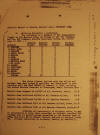
|
2.
8 January
1932.
Record of Events, Eastern Area, December
1931, Col.
L. L. Leech,
Bluefields, to
Jefe Director GN Managua, p. 2.
|
|

|
3.
8 January
1932.
Record of Events, Eastern Area, December
1931, Col.
L. L. Leech,
Bluefields, to
Jefe Director GN Managua, p. 3.
|
|

|
4.
8 January
1932.
Record of Events, Eastern Area, December
1931, Col.
L. L. Leech,
Bluefields, to
Jefe Director GN Managua, p. 4.
|
|

|
5.
8 January
1932.
Record of Events, Eastern Area, December
1931, Col.
L. L. Leech,
Bluefields, to
Jefe Director GN Managua, p. 5.
|
|

|
6.
8 January
1932.
Record of Events, Eastern Area, December
1931, Col.
L. L. Leech,
Bluefields, to
Jefe Director GN Managua, p. 6.
|
|

|
9 January
1932.
Extract of Letter Received by Capt.
Inman at Puerto Cabezas, from
Unknown.
|
|

|
12 January
1932.
Intelligence Report, Department of
Northern Bluefields Commander
Capt. O. A.
Inman, Puerto Cabezas, to Col. L.
L. Leech, Bluefields.
"DEPARTMENT OF
NORTHERN BLUEFIELDS ¶ GUARDIA NACIONAL
DE NICAGUA ¶ PUERTO CABEZAS, NICARAGUA¶
JANUARY 12, 1932. ¶ From; Department
Commander. ¶ To: Area Commander, Eastern
Area, Guardia Nacional, Bluefields,
Nicaragua. ¶ Subject: Intelligence
report. ¶ 1. The following is an extract
of a letter received by me from Mr.
Flanary, Manager of the Bragman’s Bluff
Lumber Company:= ¶ “ I quote herewith
extract from report made by our Mr. H.
E. Donalson in connection with banana
inspection trip made during the past
week up the Prinzapolka River, “Lieut.
Curcey went up the river yesterday with
thirty men. He told me that he will
establish his post at Wuani on the
Prinzapolka, but intended to take out
patrols to several points where the
bandits are reported to have camps. He
will have a radio and will be over the
Guardia at the Neptune Mine. ¶ People on
the river who have come out from Siuna
report that Altamirano split his column,
sent part of them to Bocay, and he, with
the rest of his troop went to the camp
previously established by Salgado and
Caracas at “Casa Vieja”, on the Hule
Creek. The girl Caracas took with him
from Siuna some time ago has returned to
the river, and say she has been in
Sandino’s fort and headquarters at El
Chipote. She is one of those who say
that “Pedron’s” orders, when he left
headquarters, were not to return until
he had destroyed Puerto Cabezas. The
reports are that the bandits are well
armed, but vary as to the ammunition
they may have.” ¶ 2. There is also a
persistent rumor in Prinzapolka, Puerto
Cabezas, and on the Coco River that
General Caracas has been executed by
Sandino because he (Caracas) had put
some people to death against Sandino
wish.” ¶ (Signed) O. A. Inman ¶ First
Endorsement. ¶ Headquarters Eastern
Area, G.N., Bluefields, Nic., 16 January
1932 ¶ From: Area Commander, Eastern
Area. ¶ To: Jefe Director, Headquarters
Guardia Nacional. ¶ 1. FORWARDED. ¶
(SIGNED) L. L. LEECH"
|
|

|
13 January
1932.
Extract of letter from
Col. L. L. Leech,
Bluefields, to Jefe Director GN, p. 1.
|
|

|
13 January
1932.
Extract of letter from
Col. L. L. Leech,
Bluefields, to Jefe Director GN, p. 2.
|
|
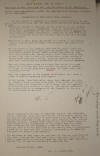
|
13 January
1932.
Text of speech by Senator
Juan Cajina Mora,
"The Mines of Wany [Wuani], Siuna
and Pis-Pis are Seized By the Bandits -
Having Their Headquarters, Within the
Departments of Jinotega, Matagalpa and
Bluefields,"
Diario Moderno
(Managua), English trans.
"DIARIO MODERNO .
Jan. 13, 1932.-- ¶ THE MINES OF WANY,
SIUNA AND PIS – PIS ARE SEIZED BY THE
BANDITS.--- ¶ Having their headquarters,
within the Department of Jinotega,
Matagalpa and Bluefields. ¶ EXPOSITION
OF JUAN CAJINA MORA, SENATOR/= ¶ In the
chamber of Senators in a session held
yesterday the Senator Juan Cajina Mora,
made the sensational exposition which
textually says: ¶ “Honorable Chamber of
Senators: As the situation at the
Atlantic Coast is every day more
deplorable, owing to circumstances that
we all know, aggravated by the lack of
exportation of Banana, the only industry
lately exploitable, I want you to know
that since a year or more the north part
of that region, has been scourged by
banditry.” ¶ “ The mines of Wany, Siuna
and Pis-Pis are seized by the Bandits
same is a great part of Puerto Cabezas
region and Comarca del Cabo”. ¶ “ No one
ignore in the Atlantic Coast that the
point within the Departments of
Jinotega, Matagalpa and Bluefields, the
Bandits have their camping places, their
General Headquarters; they also hang
around near Puerto Cabezas where they
live as they please, sure that nobody
will molest them, doing irruptions
around those desolated places, inspiring
terror every where they pass destroying
the properties and the national
richness. ¶ “The only place where there
is a force that united to a good number
of civilians hey have punished the group
of Bandits of Pedrón is at the mine
named Bonanza, but other towns are
constantly robbed. ¶ “ Near the
properties of the Bragman Bluff Lumber
Co., exist a group of bandits mastering
that region. ¶ “ At Rio Grande, Rama
Cuicuinita, where they kidnapped the
miner S. Alberto Valle and also a
merchant , a new group of bandits,
demonstrating that anarchism is
everywhere, and the necessity of
elaborate good measures to stop it, and
restore confidence and order which is so
necessary to the Republic by the ways of
constitutionalism and work.” ¶ “In my
exposition you will see honorable
Chamber, the deplorable of our
situation, is it true that so far I have
said is nothing new for you, but the
destruction of properties is so big,
specially to the foreign companies at
San Albino, Santo Domingo, La Luz and
Los Angeles, Bonanza, Bragman Bluff
Lumber Co., and others, which is great
danger to the independence of our
country when the claims come to demand
for the payments, I want you to know
that our principal duty is to the good
name of our country keep it independent,
I want you to take note that a senator
representing the Atlantic Coast has
given the alarm in this Chamber. ¶ “ In
the mines of Wany, Siuna and San Pedro
de Pis-Pis, once restored the order,
1000 men may find work, and in the other
parts of the Coast a great number of men
would gain for them and their families,
helping this to pass the situation in
which we are.” ¶ Managua 12 Jan, 1932. ¶
(s) J. Cajina Mora."
|
|

|
15 January
1932.
Report of Trip to Wuani,
Lt. L. Curcey,
Wuani Detachment, to Col. L. L. Leech,
Bluefields, p. 1.
(Note: report is
erroneously dated 15 Dec. 1931, but the
text makes clear that its correct date
is 15 Jan. 1932)
|
|

|
15 January
1932.
Report of Trip to Wuani,
Lt. L. Curcey,
Wuani Detachment, to Col. L. L. Leech,
Bluefields, p. 2.
|
|

|
16 January
1932.
Report of Wuani Detachment en route to
Wuani, Col. L. L.
Leech, Bluefields.
|
|

|
18 January
1932.
Letter from C.
Conrad Shrimer, Bluefields, to
Dr. S. H. Gapp, Moravian Church,
Bethlehem PA, p. 1.
"Dear Bro. Gapp,
¶ Brother Schramm and his family arrived
Saturday last about five o’clock in the
afternoon. Because of the smaller
children and the excessive weight of the
travelers we went to meet them in a
motor boat and brought them to the
Mission wharf from whence we took them
to the house I rented for their stay
here. ¶ It is difficult for me to answer
your letter of the 7th instant asking
for a full and frank report on the
Schramm activities on the Wangks, for I
am no in possession of the necessary
data for such a report. If you would
consult Brother Bishop, or Kenneth
Hamilton when he comes to Bethlehem, you
would be able to get some real
information, as you would also from all
the missionaries on the upper coast, for
it is in that district particularly that
the discussion and “talk” was carried on
among the people. I am sending a copy of
this letter also to Brother Danneberger
with the request that he write direct to
you and send me a copy of his letter.
Coming into contact with the Indians
from the Wangks as he does at Puerto
Cabezas he can give you also reliable
information. ¶ So far as his financial
activities or indiscretions are
concerned, these perhaps do not affect
so much his position over against the
people. When he went on furlo in 1924, I
believe that was the year, he sold to
the Musawas congregation an organ,
knowing full well that nobody there
could play it. This was long before
Brother Bregenzer took charge. The organ
stood there without use and what finally
became of it I do not know. Both times
when they went on furlo (since the
present Mrs. Schramm is in the family)
they loaded up the evangelists with
debts which the other missionaries were
asked to collect for them. But this has
not been done this second time, that is,
the missionaries are not collecting the
money due the Schramms. The evangelists
had no need for much of the stuff they
bought but were in some cases persuaded
to take the stuff against their better
judgment. ¶ Some of us felt strongly
that the Schramms had sold some of the
old clothes that were given to them by
friends in the States when they returned
from their last furlo, but Brother
Grossmann never pushed his investigation
to a conclusion because he did not want
any unpleasantness. ¶ I do know that
they had deposit accounts for themselves
and their children on my books. The
largest account was in the name of Mrs.
Schramm as he always said “It’s my
wife’s money”, and she handled the
station finances. One year transfers
were made to her account and charged
against the station, this direction
having been given to me by Brother
Schramm. But the end of that year showed
Brother Schramm owing the mission a
large sum, and without any authorization
I charged back this debt against her
deposit account, which perhaps I should
not have done without first notifying
her. But this action of mine caused
considerable comment made to the other
missionaries, (not to me direct), and in
a very short time all the money which
sister Schramm had on deposit with me
was withdrawn and sent to Wachovia,
where it . . . "
|
|

|
18 January
1932.
Letter from C.
Conrad Shrimer, Bluefields, to
Dr. S. H. Gapp, Moravian Church,
Bethlehem PA, p. 2.
" . . . is being
handled direct between the bank and
their customer. ¶ The last year they
were at Sangsangta they sent money out
of the country, presumably to Wachovia,
at the rate of almost $100 per month.
This was not done thru me, as they
evidently had lost confidence in me. Of
course they were saving this money at
the station as they had a regular ranch
of all sorts of animals, and business
was done with the Marines or anyone else
whenever opportunity offered. ¶ Brother
Schramm were employed in Nicaragua it
would have to be on the lower coast, for
he certainly could not go back to the
Wangks or anywhere north of Puerto
Cabezas, as his influence would be nil.
¶ Frankly, the financial depression and
need for retrenchment was made the
excuse-not the reason- for the solution
of a difficult problem. ¶ This is not a
satisfactory reply to your letter but I
know the other missionaries will be able
to supplement the rather meager
information I have given you. ¶
Fraternally yours, ¶ [signed] C. Conrad
Shimer ¶ Treasurer"
|
|

|
19 January
1932.
Patrol Report,
Lt. E. J. Surprenant, Kisalaya,
to Col. L. L. Leech, Bluefields.
"DISTRICT OF
KISALAYA, ¶ DEPARTMENT OF NORTHERN
BLUEFIELDS, ¶ KISALAYA, NICARAGUA. ¶ 19
January 1932 ¶ From: Lieut. E. J.
Surprenant, G.N. ¶ To: The Area
Commander, Eastern Area, Bluefields,
Nic. ¶ Via: The Department Commander
Department of Northern Bluefields,
Puerto Cabezas, Nicaragua. ¶ Subject:
Patrol Report of. ¶ References: (a)
Verbal orders of the Department
Commander, Department of Northern
Bluefields. (b) Verbal orders of the
District Commander, Kisalaya. ¶ 1. In
accordance with reference (b) cleared
Kisalaya with eight guardias for the
purpose of reconnoitering Lecus Area and
to take these guardias into Puerto
Cabezas to be exchanged as they had
completed their tour of duty at
Kisalaya. ¶ 2. Cleared Kisalaya at 1200,
12 January in pitpan and arrived Ulwas
(353-154) at 1700. Cleared Ulwas at 1800
and arrived Lecus River (340-154) at
0500, 13 January. Patrolled area. All
quiet. Proceeded and arrived Louisiana
Farm 1100 and from there into Puerto
Cabezas by motor car. Arrived Puerto
Cabezas 1900. ¶ 3. Cleared Puerto
Cabezas with 9 guardias at 1230, 16
January, in accordance with reference
(a) to investigate bandit reports at
Louisiana Farm and to work with the Moss
Farm Garrison. ¶ 4. Arrived at Louisiana
Farm at 1900, 16 January, and gained
information that bandits intended to
raid this commissary so laid ambush. As
it is next to impossible to do anything
on the lines without half the population
knowing of it, I believe that some spies
notified the bandits of our presence so
they postponed their raid. Cleared
Louisiana Farm at 0500, 17 January,
1932, arrived Moss Garrison at 0530. ¶
5. Cleared Moss Garrison in accordance
with reference (a) with Lt. Gaitan and
19 guardias proceeded over the De
Antonio trail and at 0800, 17 January,
at (337-159) planes flew over and drop
orders to investigate Lecus area.
Arrived Cuyutigni (337-154) where
evidence showed large group bandits had
camped. Proceeded to Lecus River where
Lt. Gaitán and ten guardias returned to
Moss Garrison. Laid ambush at Lecus
River. All quiet. Cleared Lecus River at
0600, 18 January and proceeded to
Kisalaya. On the trail to Kisalaya there
were two large bandit camps. One about
half way between Kisalaya and Lecus
River and the other on a small trail
leading from Laimus and running into the
Kisalaya trail. At both of these camps
they had eaten nothing but raw bananas
and this was also their diet at
Cuyutigni. There were about 75 to 80
camped in these camps on the Kisalaya
trail. It is believed that other groups
came down on the Laimus trail. Arrived
at Kisalaya at 1400, 18 January 1932. ¶
(signed) E. J. SUPRENANT ¶ 1st
Endorsement. Department of Northern
Bluefields ¶ Guardia Nacional de
Nicaragua ¶ Puerto Cabezas, Nicaragua,
17 February 1932. ¶ From: Department
Commander. ¶ To: Area Commander, Area of
the East , Bluefields, Nicaragua ¶
(signed) (---)"
|
|

|
20 January
1932.
Intelligence.
Capt. L. Curcey,
Wuani, to Col. L. L. Leech, Bluefields.
"WUANI , GUARDIA
NACIONAL DE NICARAGUA ¶ 20 JANUARY 1932.
¶ From commander Guardia, Wuani. ¶ To:
The Area Commander, Eastern Area. ¶
Subject: Intelligence. ¶ 1. December 13,
1931, Bandit jefe Pedro A. Irías with
about 90 men entered Wuani at about
11:00 PM, left a detail of 15 men and
continued thru to Siuna whereby he
entered that place at or about 4:30 AM,
December 14, stayed there with his
troops until December 19, killing and
sacking stores. ¶ 2. December 13,
Abraham Rivera and Irías met at Siuna
Road. Rivera going with Wuani with 75
men and two days later Pedro Altamirano
entered Siuna on Cuicuina trail, stayed
at Siuna that night and headed for Wuani
the next day with 150 men, where they
stayed for about 3 days and then left
Wuani December 19-1931 on Matagalpa
trail for the interior. From information
all these groups are poorly armed. I
should say only about 2/3 of them with
rifles, shotguns and breach loaders and
the rest with machetes. They have very
little ammunition. ¶ 3. It is my belief
that there are only in the neighborhood
of about 200 bandits operating in this
area. ¶ 4. Several of Siuna’s
inhabitants have just returned and state
that the Bandits carried them off to
carry loot as far as CC-18-5th Regt.
Special Map. That they were not fed on
the trip. Very evident headed for their
main camp, at Bocay. ¶ 5. No one has
come from Neptune Detachment and
therefore could not get word to your
office as to our welfare and activities.
¶ 6. The people of town along with
Guardia are cleaning town and working on
fortification of same against Bandit
attacks. It will take some time to put
in shape. ¶ 7. Health of Detachment
excellent. ¶ L. CURCEY (A SEAL)
(official copy) ¶ 1st endorsement. ¶
HEADQUARTERS EASTERN AREA ¶ GUARDIA
NACIONAL DE NICARAGUA, ¶ Bluefields,
Nicaragua. 26 February, 1932. ¶ From:
The Area Commander, Eastern Area. ¶ To:
The jefe Director, Guardia Nacional.
Managua, Nic., ¶ 1. Forwarded. ¶
(signed) L. L.LEECH"
|
|

|
1.
20 January
1932.
Report on activities in the Dept of
Northern Bluefields and Movement of
Patrols since 15 Jan 1932,
Col. L. L. Leech,
Bluefields, p. 1.
|
|
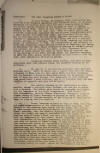
|
2.
20 January
1932.
Report on activities in the Dept of
Northern Bluefields and Movement of
Patrols since 15 Jan 1932,
Col. L. L. Leech,
Bluefields, p. 2.
|
|

|
3.
20 January
1932.
Report on activities in the Dept of
Northern Bluefields and Movement of
Patrols since 15 Jan 1932,
Col. L. L. Leech,
Bluefields, p. 3.
|
|

|
4.
20 January
1932.
Report on activities in the Dept of
Northern Bluefields and Movement of
Patrols since 15 Jan 1932,
Col. L. L. Leech,
Bluefields, p. 4.
|
|

|
21 January
1932 (2100).
Radiogram from
Comsperon to Commander 2nd
Brigade USMC, Managua.
"... RAID AT
BROWNS CAMP WAS APPARENTLY ANOTHER
ATTEMPT TO SECURE PROVISIONS PERIOD
RAIDING FORCE WAS ABOUT ONE HUNDRED MEN
WHO WERE ACCORDING TO NATIVES VERY
RAGGED AND HALF STARVED BUT WERE HOWEVER
MODERATELY WELL ARMED PERIOD GUARDIA
WHICH HAD NO WARNING OF PRESENCE OF
BANDITS WAS PREPARED FOR ATTACK PERIOD
BANDITS SCATTERED QUICKLY AS SOON AS
THEY ENCOUNTERED RESISTANCE PERIOD
GUARDIA HAS SITUATION WELL IN HAND AND
AS A PRECAUTIONARY MEASURE IS BRINGING
TWENTY ADDITIONAL MEN FROM BLUEFIELD
2100 ..."
|
|

|
25 January
1932.
Patrol Report,
Capt. Ralph D.
McAfee,
Neptune Mine, to Col. L. L.
Leech, Bluefields.
"DEPARTMENT OF
SOUTHERN BLUEFIELDS ¶ GUARDIA NACIONAL
DE NICARGUA ¶ BLUEFIELDS – NICARGUA ¶
JANUARY 25, 1932 ¶ From: Captain Ralph
D. McAfee, GN – Department of Southern
Bluefields. ¶ To: Area Commander,
Eastern Area. ¶ Subject: Patrol report.
¶ 1. On information that a small group
of bandits had cut power line between
Great Falls and Neptune Mine, the
following patrol cleared Neptune Mine at
0930, 23 January 1932: ¶ Captain Ralph
D. McAfee.; 2nd Lt. Juan B. Rodríguez ;
Cabo Martínez Carlos #1849; Raso
Cuaresma Emilio #4772; Raso Regnabarrios
Ingram #2428 ; Raso Sanchez Felix O.
#4791; Raso Villalobos Ricardo #4808;
Raso Alaniz Lanza #3084; Raso Avila
Domingo #4438; Raso Chavarría Faustino
#3742; Raso Alfredo Emilio #2272 ; ¶
Armament of patrol – 1 B.A.R., 1
T.S.M.G. , 1 rifle with grenade
Discharger, 6 rifles Krag, 1 Pistol 45,
1 pistol 38. ¶ 2. Patrol kept to right
of power line, looking for tracks of
bandits or signs of passage but none
were found. Arrived at Big Falls (110.4
– 300.95) about 1700. One man had been
seen running by a member of the patrol
but he was not molested although ordered
to halt. He was unarmed except (for) his
cutacha. It was found that a short
circuit caused by a fallen limb had been
mistaken for a cut line. This short also
caused sparks which had been mistaken
for flashlights. On 24 of January
cleared Big Falls patrolling the other
side coming back to Neptune Mines. There
were no bandit indications. ¶ 3. The
roads or trails were very muddy and it
rained all the time going and coming.
Returned to Neptune Mine about 1500. ¶
(signed) RALPH D. MCAFEE"
|
|
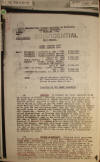
|
1 February
1932.
Extracts from
GN-2 Report Covering the Month of
January 1932.
[NOTE:
These excerpts constitute the
sum total of text devoted to the
Atlantic Coast region in this 31-page
intelligence report covering the entire
country, except the following, which are
included in chronological sequence in
these East Coast pages:
(1) 31.12.27 -
Juan Camilo Torres, Prinzapolka, letter
to sister (pp. 7-8)
(2) 32.01.08 - Extract from Record of
Events, Dept. Northern Bluefields, Capt.
Inman (p. 9)
(3) 32.01.09 - Extract from letter
received by Inman at Puerto Cabezas
(p. 16)
(4) 32.01.13 - Extract from letter from
Capt. Inman to Col. Leech (p. 9)
(5) 32.01.16 - Report of Wuani
Detachment en route to Wuani, Col. Leech
(p. 11)
(6) 32.01.20 - Report on Activities in
Dept Northern Bluefields & Movements of
Patrols since 15 January 1932, Col.
Leech (pp. 19-22)
The image to the
left is the report's cover page only.]
"
[p. 1]
LOCATION OF THE
ENEMY ELEMENTS: ¶ . .
. (B) PEDRON
ALTAMIRANO: Reported still
operating in the Eastern Area December
14 and participated in attack on Siuna
Mine (Prinzapolka) on that date.
Reported Jan 4 at Carretera [Jinotega
Dept] . . . ¶
[p. 2]
(G) SIMEON
GONZALES: Reported operating on
Dec 14 in Eastern Area and participated
in attack on Suina Mine that date.
Reported in contact with Lieutenant
Levonski Jan 18 at Brown’s Camp (Eastern
Area). ¶ . . .
[p. 3]
(P)
ABRAHAM RIVERA:
Reported operating in Eastern Area
December 14 and as having participated
in attack on Suina Mine on that date.
¶ (Q) PALMA:
Reported operating in Eastern Area and
participated in attack on Siuna Mine
December 14. ¶ (R)
PEDRO IRIAS:
Operating in Eastern Area with Pedron
and participated in attack on Siuna Mine
Dec. 14. Reported Jan 4 with his
group near Embocaderos [Jinotega]
. . . ¶ (T)
PERFECTO
CHAVARRIA: Reported, Jan 5, to be
still operating in Eastern Area in
vicinity of Puerto Cabezas.
Reported to have been killed in contact
with guardia patrol from Neptune Mine on
November 19. [NOTE:
Of the 20 jefes surveyed in this
section, the foregoing six were reported
active in the Eastern Area.]
¶ . . .
UNITS IN CONTACT.
¶ . . .
[p.
4] January 18:
Lieut Levonski and guardia patrol of 20
enlisted from Puerto Cabezas had contact
with a group of 100 bandits, jefe
unknown, at Browns Camp. One known
bandit killed. No guardia
casualties. . . . [NOTE:
Of the 5 items in this category, one was
in the Eastern Area.] ¶
. . .
STRENGTH AND MOVEMENTS. ¶
. . .
[p. 6]
Reports Jan 26 indicate main group of
bandits operating in Eastern Area has
moved northward toward Kisalaya.
[NOTE:
Of the 31 items in this category, one
was in the Eastern Area.] ¶
. . .
[p. 7]
ENEMY OPERATIONS.
¶ . . . Reported that five bandit
columns were closing in on Puerto
Cabezas, Jan 19. Jefes of columns
reported to include Pedron Altamirano,
Simeon Gonzalez, Pedro Irias. . . . Jan
30 Gonzales, Castro, Rivera group has
been reported in the Cuculaya area,
Eastern Area. They proceeded to Tunkey
on the Banbana River and then returned
to Cucalaya area. ¶ . . .
[p. 10]
OUR OPERATIONS.
¶ . . .
[p.
12] Two amphibian
planes were sent to Puerto Cabezas and
based there during the month to enable
better cooperation with the Eastern
Area. A marine detachment of nine
men was also sent there to act as
station guard and maintenance force.
¶ A detachment of one line
officer, one medical officer and twenty
enlisted was dispatched, via schooner,
from Bluefields for Puerto Cabezas on
January 19 to reinforce that place due
to seriousness of situation in Northern
Bluefields. ¶ . . .
[p.
26] PEDRON
ALTAMIRANO had General Humberto Caracas
shot for shouting “Vivas” for Sacasa. In
November, near San Pedro del Norte,
Sandino sent a letter to the Sandinista
paper “PATRIA” of San Salvador, saying
that Caracas and 10 men were shot for
treason for cheering for Juan Bautista
Sacasa. ¶ In 1927 Caracas
was one of Pres. Moncada’s Generals.
Caracas is from Rivas. One of his
brothers is a taxi chauffer in Managua.
¶ . . .
[p.
27]
ENEMY INTENTIONS.
¶ . . . Sandino is reported to
have received a new shipment of arms and
ammunition by way of Cabo Gracias a Dios
sufficient to carry out his intended
offensive. ¶ Many reports to
the effect bandits intend to make a
determined effort against Puerto Cabezas
this month Jan 21. ¶ . . .
[p. 29]
SUMMARY OF
INTELLIGENCE TO INCLUDE 23 JANUARY 1932:
¶ . . .
[p.
30]
EASTERN AREA:
¶ The group operating near Brown’s
Camp has disappeared for the time.
This group seems to have confined its
activity mostly to an attempt to raid
Brown’s Camp and collect provisions.
¶ . . . .
CONCLUSIONS: ¶ . . .
(3) The group in the Eastern Area will
continue to opeate between the Rio
Kukalaya and the Rio Hueso in the hopes
of raiding stores and forcing
contributions. . . ."
|
|

|
1.
1 February
1932.
Record of Events, Eastern Area, January
1932, Col. L. L.
Leech, Bluefields, p. 1.
"GUARDIA NACIONAL
DE NICARAGUA ¶ CUARTEL GENERAL, AREA DEL
ESTE ¶ 1 February 1932 ¶ From: Area
Commander, Eastern Area. ¶ To: The Jefe
Director, Headquarters Guardia Nacional
de Nicaragua, Managua. ¶ Subject: Record
of Events, Eastern Area, JANUARY 1932. ¶
Reference: General Order, No. 140 –
1929. ¶ Subject: Record of events,
Eastern Area, JANUARY 1932. ¶ 3.
Contacts: ¶ PLACE : BROWNS CAMP, ¶
PATROL COMDR. Lt. LEVONSKI ¶ DATE Jan.
18th ¶ RESULTS One (1) bandit killed.
One repeating rifle captured. ¶ D.
POLICE OPERATIONS. 1. See Departmental
Reports. ¶ 2. General Police Conditions.
Satisfactory. On January 14, 1932, a
band of ten robbers chopped entrances
into two Chinese stores at MUELLE REAL
on the RIO SIQUIA, fired a few pistol
shots and robbed the stores of some
$1000.00 worth of general merchandise.
The District Commander, Lieutenant
CASPERONIS, immediately dispatched
guardia in pursuit, covering the various
trails and settlements in the vicinity,
and within twenty-four hours effected
the capture of four of the robbers, and
located and returned to owners about
$800.00 worth of the stolen goods,
including $1000 in cash. The prompt and
efficient action of the District
Commander of Rama, in this case, has
done much to increase the prestige and
authority of the Guardia in the
vicinities of the ESCONDIDO, SIQUIA and
MICO RIVERS. ¶ E. INTELLIGENCE. ¶ 1.
General State of Territory Occupied . In
the northern half of the Area acute
apprehension prevails on account of the
attempted raid of the BROWNS CAMP
commissary by the GONZALES group in the
middle of the month. It has since been
learned that this group was desperately
in need of food, to the point of
starvation, and that they were not well
armed. Their prisoners who escaped and
returned stated that they struck down
and devoured a cow, raw, almost before
it expired, and that the entire group
were startled into hiding at the sharp
sound of breaking of a tree limb. Altho
the detailed reports from their
devastation of TUNKY have not been
received, it can be believed that this
action was one of raid and loot, solely.
At the present time, the GONZALES,
CASTRO, RIVERA group are reported as
enroute from TUNKY back to the KUKALAYA
DISTRICT of Northern Bluefields. Three
spies appeared in the vicinity of and
inside the town of RIO GRANDE BAR,
during the period, asking such revealing
questions as to the number, the
disposition, and supports of the Guardia
post, as well as the number of Chinese
stores in RIO GRANDE BAR. This spy work
is considered as a possible forerunner
of a raid on either PRINZAPOLKA or RIO
GRANDE BAR, from the NORTH. ¶ -4- [...]"
|
|
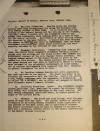
|
2.
1 February
1932.
Record of Events, Eastern Area, January
1932, Col. L. L.
Leech, Bluefields, p. 2.
"[...] Subject:
Record of Events, Eastern Area, JANUARY
1932. ¶ 2. Military Situation: Guardia
post and Guardia patrols have been
strengthened all along the railroad line
from PUERTO CABEZAS to MOSS FARM. It is
believed that the burning of the several
houses and the killing of two workmen,
(natives) there, together with the
attempted raid on the BROWN’S CAMP
commissary, were opening moves in a plan
to wipe out the entire railroad.
Reoccurrence of these raiding tactics
are expected in the near future. A
report has been received via runner to
NEPTUNE and radio to BLUEFIELDS, that
the WUANI detachment established post
under quiet conditions, and were
heartily welcomed by the citizens of
that town. ¶ 3. Economic Conditions:
Commencing with January 27, 1932, the
United Fruit Company’s steamship
schedule contemplates only one sailing
per two weeks between NEW ORLEANS and
BLUEFIELDS, instead of the old, regular
weekly schedule. The lagging banana
market in the United Sates is given as
the reason for this action. The banana
handlers and workers on the power barges
and tugs made an ineffective threat to
strike when informed of the consequent
curtailment of labor hours, but no
serious developments have resulted thus
far. Business in general throughout the
Area is slow. ¶ 4. No friction between
Guardia and civil population has been
reported in the period. The press
continues to be friendly and cooperative
with the Guardia. During the period a
new, weekly newspaper made its
appearance in Bluefields. It is called
“EL 2 DE MAYO”, and is edited and
managed by General José Alejandro Pasos
y Romero, Liberal. ¶ 5. Political
Situation. Quiet. The RIGOBERTO CABEZAS
Liberal, political club, mentioned in
report for November, 1931, held three,
well attended meetings in the local
theatre. The new, weekly newspaper,
mentioned above, is almost purely an
organ of the Liberal party. ¶ 6.
Weather. The month has been stormy, with
frequent gusts of high wind and rain.
The unusual amount of rainfall in
January is an extraordinary occurrence
in the experience of the natives of the
East Coast, and is practically unknown.
The almost continuous fall of rain in
January is believed to have had a
surprise, adverse effect on the bandit
depredations in the Puerto Cabezas
vicinity. -5- [...]"
|
|
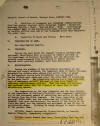
|
3.
1 February
1932.
Record of Events, Eastern Area, January
1932, Col. L. L.
Leech, Bluefields, p. 3.
"[...] Subject:
Record of Events, Eastern Area, JANUARY
1932. ¶ 7. Condition of telephone and
telegraph communications. Civilian
system, Tropical Radio Telegraph Company
– Excellent. Kisalaya Guardia – Good.
Neptune Mine – Good. Interruption for
several days in the Neptune-Bluefields
service was caused by bandits cutting
down one or two telegraph poles that
supported the power line. ¶ 8. Condition
of Roads and Trails. Very poor. ¶ F.
CONFISCATION OF ARMS. See Departmental
Reports. ¶ G. TRAINING. During the past
month the regular training schedule was
seriously interfered with on account of
bandit activity in the Department of
Northern Bluefields, and the necessity
for sending reinforcements from
Bluefields to Puerto Cabezas. Regular
drill periods, however, have been
maintained. ¶ H. MISCELLANEOUS. During
the absence of the Bluefields detachment
of one officer and twenty enlisted, for
temporary duty in Puerto Cabezas,
seventy-five cívicos were called into
active duty, on guard at the approach
trails into Bluefields, and one outpost
of twelve cívicos were stationed about
six miles WEST of Bluefields on the main
trail. The Bluefields cívicos are a very
excellent type of emergency soldier, and
most of them have fought in previous,
revolutionary actions. They are eager
for service, and performed guard duty
for a period of three days in most
satisfactory manner. ¶ The inspections
by the Area Commander and the Area
Surgeon of the Department of Northern
Bluefields were hampered considerably by
the increased amount of patrolling and
action in the field of troops from the
Ninth Company. The close inspection of
the patrols, KIPLA FARM, and the
storerooms and buildings in PUERTO
CABEZAS, were most satisfactory, the
morale of the troops in the field was
good, and the clothing and equipment of
men is fair to satisfactory shape.
Clothing is being shipped to Puerto
Cabezas, at the present time. ¶ CIVICOS:
Puerto Cabezas – 50; Bluefields – 75; La
Cruz – 12; Neptune Mine – 76; Rama –
Being reorganized. ¶ British Consul
Edmund Owen Rees, Bluefields, died. Jan.
27, ¶ (Signed) L. L. LEECH"
|
|

|
2 February
1932.
Patrol Report,
Capt. Ralph D. McAfee, Neptune
Mine, to Col. L. L. Leech, Bluefields,
p. 1.
"DEPARTMENT
SOUTHERN BLUEFIELDS ¶ GUARDIA NACIONAL
DE NICARGUA ¶ BLUEFIELDS – NICARAGUA
FEBRUARY 2, 1932. ¶ From: Ralph D.
McAfee, Captain GN de NIC ¶ To: The Area
Commander, Eastern Area. ¶ Subject:
Patrol report. ¶ 1. A patrol consisting
of: Ralph D. McAfee, Captain; Adrián
Somarriba, 2nd Lt.; T. E. Cody 2nd Lt.
(Radio); Martínez Carlos Cabo #1849;
Cuaresma Hernandez Raso#4772; Narciso
Fernandez Raso #4745; Alemán Francisco
Raso #4807; Avila Domingo Raso #4438;
Regnabarrios Ingram Raso #2428; Sánchez
Félix O. Raso 34791; Villalobos Ricardo
Raso #4808; 2 Cívicos, guides and
Muleros; 2 pack animals. ¶ Armament of
patrol: 1 B.A.R., 1 Rifle Springfield, 7
rifles Krag, 2 Pistols 45, 1 Revolver
38. ¶ Cleared Neptune Mine at 0800 for
Wuaní 26 January 1932. ¶ 1200 passed
through El Limón. 0430 camped at Juanón
(100.9-290.9) – a deserted cattle farm.
The trail was bad and it rained
constantly. ¶ 27 January 0800 cleared
Juanón. Traveled six hours over the
mountain leading into El Dorado. There
are no houses between Juanón and El
Dorado. El Dorado is part of the La Luz
Mining District. The valley is about
eight miles long. ¶ 0300 camped in lower
El Dorado. ¶ 28 January: 0700 cleared El
Dorado. 0800 came to Siuna, Wuaní road,
which is very bad but has been opened
since Lieutenant Curcey came to Wuaní. ¶
1100 arrived Wuaní. ¶ 29 January: Held
inspection. Measured field for aviation
landing, field which was found entirely
too small for [...]"
|
|

|
2 February
1932.
Patrol Report,
Capt. Ralph D. McAfee, Neptune
Mine, to Col. L. L. Leech, Bluefields,
p. 2.
"[...]
consideration. Lieutenant Cody made
estimate as to need in case of radio
installation. ¶ At 1600 a messenger from
Neptune arrived saying that Tunky had
been sacked, also that 300 bandits were
moving in direction of Wuani and Neptune
from Jinotega. This last information was
from Area Commander. ¶ 30 January: 0700
cleared Wuaní. ¶ 1700 camped in Mountain
between Limones and El Dorado. ¶ 31
January: 0600 cleared camp. ¶ 0900
intercepted messenger saying that
bandits might take the Tunky-Casa Vieja
road passing through El Limón. (El Limón
is 110.3-300.3) Harlan Pefley Map. ¶
1500 camped at El Limón on Casa Vieja
road. No result nor sign of bandits. ¶ 1
February: 0700 A messenger from Neptune
reported bandits to Northeast of
Neptune. Cleared immediately for Neptune
arriving about 1000; upon arrival Lt
.Gray cleared on patrol with all the
Guardia in Neptune that were not on
returning patrol. It was necessary to
send Lt. Gray, because Lt. Rodriguez was
sick, while Lt. Somarriba and myself had
just returned. ¶ 2. The trail to Wuaní
is very bad. It rained constantly; or at
least three or four times a day, every
day. Practically the whole patrol were
without shoes on the return trip. There
is no food to be procured anywhere on
the trip, as bananas are scarce and
there are not more than three inhabited
houses between Neptune and El Dorado. ¶
(signed) RALPH D MCAFEE ¶ First
Endorsement ¶ HEADQUARTERS EASTERN AREA
¶ GUARDIA NACIONAL DE NICARAGUA ¶
Bluefields, Nicaragua 18 February 1932 ¶
From: Area Commander, Eastern Area. ¶
To: Jefe Director, Headquarters, Guardia
Nacional de Nicaragua, Managua,
Nicaragua ¶ 1. Forwarded. The principal
reason for this patrol was inspection of
the new post at Wuaní, commanded by
Lieut. Curcey. Captain McAfee found the
garrison well situated, defense and
military positions satisfactory, morale
and health of the post good. Rations
furnished this post by Chinese merchants
there, by special agreement, excellent.
¶ (signed) L. L. LEECH"
|
|
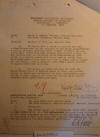
|
2 February
1932.
Contact of Civicos, Neptune Mine.
Capt. Ralph
D. McAfee, Neptune Mine, to Col.
L. L. Leech, Bluefields, p. 1.
"DEPARTMENT OF
SOUTHERN BLUEFIELDS ¶ GUARDIA NACIONAL
DE NICARGUA ¶ BLUEFIELDS, NICARAGUA 2
FEBUARY 1932 ¶ From: Ralph D. McAfee,
Captain, Guardia Nacional. ¶ To: The
Area Commander, Eastern Area. ¶ Subject:
Contact of civicos, Neptune Mine. ¶ 1.
On report that a group of bandits that
had robbed Tunkey wee in the vicinity of
Big Falls (110.4-300.9) a patrol of
seven civicos under command of Pedro
Jarquin, (civilian) armed with Krag
Rifles, encountered a group of six
bandits near the Biltigni River
(110-5-310.1). This group were cutting
balsa wood to be used in rafts. They
were surprised at this work and four of
their number killed and two Muzzle
loading shotguns captured. A small
quantity of black powder was captured. ¶
2 The action of these civicos who left
Big Falls (Power Plant of Neptune Mine)
of their own accord; acting on their own
information is very commendable,
especially of Pedro Jarquin who lead the
patrol. This contact occurred about 1000
1 February 192. ¶ (signed) RALPH D.
McAFEE ¶ 1st endorsement ¶ HEADQUARTERS
EASTERN AREA GUARDIA NACIONAL DE
NICARAGUA Bluefields, Nicaragua 18
February 1932. ¶ From The Area
Commander, Eastern Area. ¶ To: The Jefe
Director, Guardia Nacional, Managua,
Nicaragua ¶ 1. Forwarded. ¶ 2. The
prompt action of the Civicos, under
Pedro Jarquin is most commendable, and
well illustrates the spirit and
initiative at all times displayed by the
Civicos at Neptune Mine. Mr. Springer is
fortunate to have such loyal and
fearless employees, and the Guardia
grateful for such valuable assistance. ¶
(signed) L. L. LEECH"
|
|


|
5 February
1932.
Contact of Civicos, Neptune Mine.
Capt. Ralph
D. McAfee, Neptune Mine, to Col.
L. L. Leech, Bluefields, p. 2.
(2 images)
"GUARDIA NACIONAL
DE NICARAGUA ¶ CUARTEL GENERAL, AREA DEL
ESTE ¶ BLUEFIELDS, NICARAGUA. 5 February
1932. ¶ From: The Area commander,
Eastern Area. ¶ To: The Jefe Director,
Guardia Nacional, Managua, Nicaragua. ¶
Subject: Report of contacts. ¶ 1. The
following is a copy of a radio received
February 5, covering three contacts near
Neptune Mine. ¶ Neptune Mine Feb 3, 1932
(received Bluefields on 5th) ¶ COMMANDER
GUARDIA ¶ BLUEFIELDS ¶ CIVICOS MADE
CONTACT ONE FEBRUARY FOUR BANDITS KILLED
TWO SHOTGUNS CAPTURED ONE CIVICO WOUNDED
PERIOD LT GRAY MADE TWO CONTACTS ABOUT
1300 AND 1600 TWO FEBRUARY FIVE COUNTED
KILLED NUMBER WOUNDED NO GUARDIA
CASUALTIES PERIOD CAPTURED FOUR ARMS AND
AMMUNITION. DESTROYED GREAT QUANTITY
LOOT. RETURNED THREE FEBRUARY DUE TO
LACK OF AMMUNITION PERIOD AM CLEARING
WITH FRESH PATROL 12003 ¶ MCAFEE ¶ 2.
This bandit group is evidently the one
under Gonzales, Rivera and Castro, who
raided and burned Tunky on January 30,
1932, and retreated to the Northeast.
The above, report indicates that they
were traveling slow, carrying their
loot, and were intercepted by the
Neptune patrols. The heavy casualty list
and the capture of the stolen loot,
should seriously cripple the activities
of this group for a time, and ease the
situation in the Department of Northern
Bluefields. ¶ 3. The following radio
from Kisalaya indicates probable local
activity in that area. ¶ PTO CABEZAS FEB
4 1932 ¶ NGOVT GUARDIA COMANDANTE ¶
BLUEFIELDS ¶ SEVERAL SHOTS FIRED INTO
KISALAYA MIDNIGHT LAST NIGHT BELIEVED
SMALL GROUP MARAUDERS UNDER RAFAEL
BLANCA OPERATING AROUND LAIMUS HENDERSON
NOW IN THAT AREA INVESTIGATING 14304. ¶
INMAN. ¶ -1-"
|
|
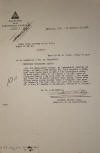
|
4 February
1932.
Informes from
Antonio Flores Vega, Ministro de
Gobernación to Gen. C. B. Matthews, Jefe
Director GN, Managua.
"INFORMES
RECIBIDOS DICEN: Que los
bandoleros tienen su campamento general
en Bocay, situado a 276 millas del Cabo
Gracias a Dios. Aquí está desde
hace un año.- Los bandoleros salen de
este punto sobre el río Bocay y de ahí
toman el afluente Hamaca y de este caño
se cruzan a las vigas del Guaní en el
punto llamado Casa Vieja. Desde
este último punto ellos pueden tomar 3
caminos: uno para las minas de Pis Pis;
otro por agua río abajo a Guaní; y otro
al camino de Matagalpa, adelante de
ellas. ... "
|
|

|
4 February
1932.
Report of Bandit Attack Against Guardia
Garrison at Kisalaya,
2nd Lt. E. J.
Surprenant, Kisalaya, to Col. L.
L. Leech, Bluefields.
"DISTRICT OF
KISALAYA ¶ DEPARTMENT OF NORTHERN
BLUEFIELDS, ¶ KISALAYA, NICARAGUA. 4
February 1932. ¶ From: the District
Commander. ¶ To: The Area Commander,
Eastern Area, Bluefields, Nic. ¶ Via:
The Department Commander, Department of
Northern Bluefields, Puerto Cabezas,
Nicaragua. ¶ Subject: Bandit attack
against Guardia Garrison at Kisalaya,
report of. ¶ 1. The following is a
report of an attack on Kisalaya, by a
bandit group estimated at ten. ¶ 2. At
0030 on the morning of 4 February 1932,
the officer’s quarters were fired upon
by bandits from south west and about 200
yard of this post. Officers and Guardia
immediately manned their defense
stations and guardias in trenches due
west returned fire. ¶ 3. Bandits after
firing about 25 rounds into camp
dispersed in general direction of
Laimus. In this attack bandits employed
rifles and pistols. ¶ 4. This group was
under Commandante Rafael Blanco. A
patrol from this post sometime last
October wounded Blanco who ran as patrol
entered Laimus (Pefleys Maps,
coordinates 352-141). It is my belief
that Blanco intended only to make a
demonstration because as soon as guardia
returned fire, bandits took to bushes. ¶
5. The conduct and discipline of all
guardia was excellent. ¶ (signed) E. J.
SURPRENANT ¶ 1st. Endorsement. ¶
Department of Northern Bluefields
Guardia Nacional de Nic. ¶ Puerto
Cabezas, Nicaragua 17 February 1932. ¶
From: Department Commander. ¶ To: Area
Commander, Area of the East, Bluefields,
Nic. ¶ 1. Forwarded. ¶ (signed) O. A.
Inman ¶ 2nd Endorsement ¶ 19 February,
1932. ¶ HEADQUARTERS, EASTERN AREA,
GUARDIA NACIONAL DE NICARGUA.
Bluefields, Nicaragua. ¶ From: The Area
Commander, Eastern Area. G.N. ¶ To: Jefe
Director, G.N. Managua. ¶ 1. Forwarded.
¶ (signed) L. L. LEECH"
|
|
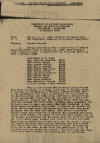
|
1.
4 February 1932.
Contact Report, 2nd Lt. Earl T. Gray,
District of Neptune Mine, to Col. L. L.
Leech, Bluefields, p. 1.
"DEPARTMENT OF
SOUTHERN BLUEFIELDS ¶ GUARDIA NACIONAL
DE NICARAGUA ¶ BLUEFIELDS, NICARAGUA ¶ 4
FEBRUARY 1932. ¶ From: 2nd Lt. E. T.
Gray, District of Neptune Mine. ¶ To:
The Department Commander of Southern
Bluefields. ¶ Subject: Contact report. ¶
1. Having information that a large group
of bandits which had sacked Tunky on
January 28, 1932, were cutting a road to
Waspook river, I cleared with the
following patrol at 1200 1 February,
1932. ¶ Lieutenant E. T. Gray. Sgt.
Constine Casanova #2701, Cabo Eliseo
Vargas, #2130, Raso Acdana Rodolfo
#2485, Raso Emilio Alfredo #2272, Raso
Alaniz Gumercindo #3084, Raso Domingo
Avila #4458, Raso Chavarría Faustino
#3742, Raso Chavas Rafael #4746, Raso
Garzón Jesús #4809, Raso Gomez Leonardo
#3283, Raso Alejandro Gorgona #3489, 2
civil guides. 2 pack animals. ¶ Patrol
took a north east direction going
through Eden Mines and camped in a small
house near to Biltigni river, a
tributary of the Waspook. 2 February
cleared at 0600. Here it was necessary
to cut trail to intercept the route
taken by the bandits column. Cut trail
until 1100 when a distinct trail of the
bandits was found. This was followed for
a short distance where it entered into
the Biltigni River. Here the bandits had
followed the river banks, crossing where
necessary. The Biltigni river is small
and rapid. The trail indicated a very
large number of bandits. About 1200 a
clearing was entered but which had not
been under cultivation for some time
being grown up higher than the head with
weeds. Here partly constructed bandit
camps were found but no bandits. We
proceeded cautiously seeing fresh
tracks. The banks of the river were
steeper and the two guides, six guardias
and the mules were letf after we cleared
the first bandit camp, because they
could not follow the trail. When I had
proceeded about a half mile down the
river, a bandit approached the river
bank from the opposite side with a balsa
log. (Which were used in construction of
rafts). This was the first man we had
seen. He was about 100 yards ahead of
us. We proceeded now very slowly and
quietly. The river bank had dense cover
which was fortunate. Our presence was
not discovered. [...]"
|
|
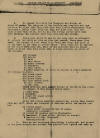
|
2.
4 February 1932.
Contact Report, 2nd Lt. Earl T. Gray,
District of Neptune Mine, to Col. L. L.
Leech, Bluefields, p. 2.
"[...] 2. We
opened fire with the Thompson and B.A.R.
at about 20 yards. The surprise of the
bandits was complete and our position so
close that they fled with very little
resistance. They returned a feeble fire
from the camp and some more from the
high ground back of it, but in all the
firing lasted less than five minutes.
The bandits used only shotguns and
rifles. ¶ 3. There were about 75 men in
the camp when we attacked. We crossed
the river as soon as fire had ceased.
There were five dead. The amount of loot
taken from Tunky was large and most of
it lay here in the camp in rubber sacks.
This could not be carried as our mules
were worn out. Most of the articles were
in rubber sacks of which they were about
100. A rough estimate is given of the
content. ¶ 100 trousers; 100 shirts; 50
hats; 50 pairs shoes; 25 women dresses;
75 blankets; 20 rain coats; ¶ A great
quantity of cloth in pieces. A great
quantity of cooking utensils; ¶ 200
pound beans; 300 pound rice; 200 pound
sugar; 300 tins canned food; 20 lbs.
coffee; 5 lbs. tea. ¶ These articles
were either burned or thrown in the
river. The amount of Military articles
were: ¶ 1 rifle Krag; 3 shotguns; 4
clips for Lugar pistol; ½ lb. powder. ¶
About 200 rounds assorted ammunition,
mostly Krag Combat 1930 and 1917, which
was reissued to Guardia after the second
combat. ¶ 36 rounds Lugar; 6 round brass
shotgun 12 and 16 gauge, Remington
reloaded; 12 rounds 38 special pistol
Winchester;30 Machetes; 2 pack bulls.
(Killed in combat) 5 bandits killed.
(Counted). Correspondence. ¶ 4. When we
had destroyed everything, I returned and
picked up the pack animals and guides.
The guardia left behind had came up
[...]"
|
|

|
3.
4 February 1932.
Contact Report, 2nd Lt. Earl T. Gray,
District of Neptune Mine, to Col. L. L.
Leech, Bluefields, p. 3.
"[...] 2. We
opened fire with the Thompson and B.A.R.
at about 20 yards. The surprise of the
bandits was complete and our position so
close that they fled with very little
resistance. They returned a feeble fire
from the camp and some more from the
high ground back of it, but in all the
firing lasted less than five minutes.
The bandits used only shotguns and
rifles. ¶ 3. There were about 75 men in
the camp when we attacked. We crossed
the river as soon as fire had ceased.
There were five dead. The amount of loot
taken from Tunky was large and most of
it lay here in the camp in rubber sacks.
This could not be carried as our mules
were worn out. Most of the articles were
in rubber sacks of which they were about
100. A rough estimate is given of the
content. ¶ 100 trousers; 100 shirts; 50
hats; 50 pairs shoes; 25 women dresses;
75 blankets; 20 rain coats; ¶ A great
quantity of cloth in pieces. A great
quantity of cooking utensils; ¶ 200
pound beans; 300 pound rice; 200 pound
sugar; 300 tins canned food; 20 lbs.
coffee; 5 lbs. tea. ¶ These articles
were either burned or thrown in the
river. The amount of Military articles
were: ¶ 1 rifle Krag; 3 shotguns; 4
clips for Lugar pistol; ½ lb. powder. ¶
About 200 rounds assorted ammunition,
mostly Krag Combat 1930 and 1917, which
was reissued to Guardia after the second
combat. ¶ 36 rounds Lugar; 6 round brass
shotgun 12 and 16 gauge, Remington
reloaded; 12 rounds 38 special pistol
Winchester;30 Machetes; 2 pack bulls.
(Killed in combat) 5 bandits killed.
(Counted). Correspondence. ¶ 4. When we
had destroyed everything, I returned and
picked up the pack animals and guides.
The guardia left behind had came up
[...]"
|
|
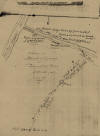
|
4.
4 February 1932.
Contact Report, 2nd Lt. Earl T. Gray,
District of Neptune Mine, to Col. L. L.
Leech, Bluefields, p. 4.
Sketch of Scene
of Contact of Lieut. Gray, GN, 2
February 1932.
|
|

|
5.
4 February 1932.
Contact Report, 2nd Lt. Earl T. Gray,
District of Neptune Mine, to Col. L. L.
Leech, Bluefields, p. 5.
"[...]
DEPARTMENT OF SOUTHERN BLUEFIELDS ¶
GUARDIA NACIONAL DE NICARAGUA ¶
BLUEFIELDS, NICARAGUA ¶ FEBRUARY 15,
1932. ¶ From: The Department Commander.
¶ To: The Area Commander, Eastern Area.
¶ Subject: Contact Report. Forwarded. ¶
Reference: Harlan Pefley map. ¶ 1. The
contacts as reported by Lt. Gray took
place at (110.6 – 310.3) Harlan Pefley,
the second (110.7 – 310.2). ¶ 2. The
conduct of Lt. Gray, who cleared on my
orders (due to there being no other
available officers my patrol and myself
had just returned and were nearly
exhausted. Lt. Rodriguez was sick), was
of the highest order of skill and
courage. I personally covered the ground
where both contacts took place and the
defeat of the bandits was complete in
both contacts. Such additional property
taken from the bandits, and destroyed by
my patrol later, was due to the initial
contacts of Lieutenant Gray. ¶ One
additional dead bandit was found which
made six killed by Lt. Gray patrol in
the first contact. While no estimate was
made of the wounded two Indians who
being held captives, and who escaped
during the contacts stated that Simon
Gonzalez and Julio Castro were wounded.
This is not certain by any means but is
merely added as a matter of interest. ¶
3. The Jefes were Pedro Irías, Simón
Gonzalez, Perfecto Chavarría and Julio
Castro, a new but blood thirsty addition
to the bandit forces. ¶ 4. The complete
forces of the bandits and an estimate of
the goods destroyed make it certain that
the bandits did not profit by their
robbery of Tunky except for clothing
they may have worn away. I consider this
the most severe blow the bandits have
been struck on this coast, as to loss of
stolen property, and to my belief the
largest recovery of stolen loot in the
history of the Guardia. The action of
Lt. Gray and the patrol deserve the
highest commendation. ¶ (signed) RALPH D
MCAFEE [...]"
|
|

|
6.
4 February 1932.
Contact Report, 2nd Lt. E. T. Gray,
District of Neptune Mine, to Col. L. L.
Leech, Bluefields, p. 6.
"[...] Second
Endorsement ¶ HEADQUARTERS EASTERN AREA
GUARDIA NACIONAL DE NICARAGUA ¶
Bluefields, Nicaragua 18 February 1932 ¶
From: Area Commander, Eastern Area. ¶
To: The Jefe Director, Headquarters,
Guardia Nacional de Nicaragua, Managua.
¶ Subject: Contact Report, Lieut. Gray,
(R), G.N. on February 2, 1932, at
BILTIGNE RIVER. ¶ 1. Forwarded ¶ 2. From
a study of Lieut. Gray’s report and from
personal conversation with Captain
McAfee, who explained satisfactorily the
reason for sending Lieut. Gray, (Radio),
G.N. on the patrol, too much credit
cannot be given for the action of Lieut.
Gray in boldly attacking first the large
main camp of the bandits with only six
(6) Guardia, completely surprising and
routing the bandits, seizing and
destroying their stolen loot of several
raids, capturing a mass of papers and
killing six and wounding others. ¶ 3.
Being rejoined by the remainder of his
patrol and having completely dispersed
the main group, Lieut. Gray promptly
turned back on the trail, suspecting the
presence of a rear guard, and was
ambushed, but fortunately without any
casualties. After a spirited long range
fire action the bandits scattered and
vanished. ¶ 4. The manner in which
Lieut. Gray led and handled his small
patrol, the boldness of his attack
against such a large force, and the
results attained receive my admiration;
he and his patrol deserve the highest
commendation. Such conduct on the part
of the officers and enlisted men of the
Guardia Nacional and especially on the
part of Lieut. Gray, who is not a line
officer, and subject to combat and
patrol duty, cannot fail to leave its
imprint on the morale and future of the
Guardia Nacional. ¶ 5. I recommend that
Second Lieutenant Earle T. Gray,
(Radio), Guardia Nacional, be officially
commended in official orders for his
conduct and splendid results. ¶ (signed)
L. L. LEECH ¶ (APPROVED) (A SIGNATURE)
[...]"
|
|

|
7.
4 February 1932.
Contact Report, 2nd Lt. E. T. Gray,
District of Neptune Mine, to Col. L. L.
Leech, Bluefields, p. 7.
Transmittal of
untranslated bandit correspondence.
Enclosures: (25). "... 1.
Forwarded herewith are twenty-five
pieces of untranslated bandit
correspondence (excluding pictures and
envelopes), memorandums, personal
letters, and newspaper clippings.
Some of this correpondence originated
from Pedro A. Irias, E. Carvajal, I.
Perfecto Chavarria, R. R. Hernandez,
Carlos Salgado, Coronel Candelario, and
bandit sub-jefes. 2. This
correspondence was captured by 2nd
Lieut. Earle T. Gray, (Radio), G.N., in
his contact with bandit group at
BILTIGNE RIVER, on February 3, 1932.
A part of this correspondence was
brought to Neptune Mine by Lieut. Gray,
and a large part was returned to Neptune
Mine by Captain Ralph D. McAfee during
his patrol to scene of BILTIGNE RIVER
contact, on February 5, 1932. /s/ "
|
|

|
8.
4 February 1932.
Contact Report, 2nd Lt. E. T. Gray,
District of Neptune Mine, to Col. L. L.
Leech, Bluefields, p. 8.
"Transmittal of
original, signed documents and letters
from A. C. Sandino, Pedro A. Irias, I.
Perfecto Chavarria, and Abraham Rivera,
with translations. Enclosures:
(12). ¶ 1. Transmitted hereiwth are
twelve (12) original signed documents
and letters from A. C. Sandino, Pedro A.
Irias, I. Perfecto Chavarria, and Abrham
Rivera, with translations. ¶
2. This correspondence is the more
important of papers captured by Second
Lieutenant Earle T. Gray, (R), G.N., in
his contact with bandit group at
BILTIGNE RIVER, on February 3, 1932.
Part of this lot was returned to Neptune
Mine by Lieutenant Gray, after his
action, and a large part was seized by
Captain Ralph D. McAfee, in his patrol
to scene of contact at BILTIGENE RIVER,
on February 5, 1932. ¶ (signed) L. L.
LEECH"..."
|
|
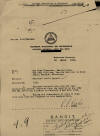
|
9.
4 February 1932.
Contact Report, 2nd Lt. E. T. Gray,
District of Neptune Mine, to Col. L. L.
Leech, Bluefields, p. 9.
"Subject: Captured bandit
papers. ¶ Enclosures: (17).
¶ 1. Enclosed herewith are more
and very eluminating papers, captured
from the bandits by Lt. Gray (R) GN,
after his contacts on Feb 2 and
3rd, 1932. ¶ 2. Copies and
translation of some of them have been
made and retained at this headquarters.
¶ (signed) L. L. LEECH"
|
|
|
|
|
PREVIOUS
NEXT |
|
|
|
|
|
|
|
